lock Abarth 124 Spider 2020 Owner handbook (in English)
[x] Cancel search | Manufacturer: ABARTH, Model Year: 2020, Model line: 124 Spider, Model: Abarth 124 Spider 2020Pages: 224, PDF Size: 3.9 MB
Page 42 of 224

turn and loosen the cap screws until
the screws start to spin free fig. 36;
pull out the cap and open the boot
lid fig. 37. After performing this
emergency measure, contact an Abarth
Dealership as soon as possible.
IMPORTANT Do not pull the screw
when pulling the cap. Otherwise, the
screw may fall off and become lost.
WARNING
48)Never allow a person to ride in the
boot: allowing a person to ride in the boot
is dangerous. The person in the boot could
be seriously injured or killed during sudden
braking or a collision.
49)Do not drive with the boot lid open:
exhaust gas in the cabin of a vehicle is
dangerous. An open boot lid in a moving
vehicle will cause exhaust gas to be drawn
into the cabin. This gas contains CO
(carbon monoxide), which is colourless,
odourless, and highly poisonous, and it
can cause loss of consciousness and
death. Moreover, an open boot lid could
cause occupants to fall out in an accident.
50)Close the boot lid, do not allow
children to play inside the boot lid. Leaving
the trunk lid open or leaving children in the
vehicle with the keys is dangerous.
Children could open the boot lid and climb
inside resulting in possible injury or death
from heat exposure.
51)Always keep the car from being a
tempting place to play by latching the
doors and the boot lid, and keeping the
keys where children can not play with
them. Leaving children or animals
unattended in a parked vehicle is
dangerous. Babies left sleeping and
children who lock themselves in cars or
trunks can die very quickly from heat
prostration. Do not leave your children or
pets alone in a car at any time. Do not
leave the car, the boot lid unlocked.
3408080100-121-004AB
3508080100-122-001AB
3608080100-999-400AB
3708080100-124-003AB
40
GETTING TO KNOW YOUR VEHICLE
Page 43 of 224

BONNET
OPENING
52) 53) 54) 56)
Proceed as follows:
with the vehicle parked, pull the
release handle 1 fig. 38 to unlock the
bonnet;
insert your hand into the bonnet
opening, slide the latch lever 2 to the
right fig. 39 and lift up the bonnet;
release support rod 3 fig. 40 from its
locking device, then insert it in the
padded area 4 fig. 41 and secure it in
the support rod hole indicated by the
arrow to hold the bonnet open.CLOSING
55)
Proceed as follows:
check under the bonnet area to
make certain all filler caps are in place
and all loose items (e.g. tools, oil
containers, etc.) have been removed;
lift the bonnet, grasp the padded
area on the support rod, and secure the
support rod from its locking device.
Verify that the support rod is secured in
the clip before closing the bonnet;
lower the bonnet slowly to a height of
about 20 cm above its closed position
and then let it drop.
IMPORTANT When closing the bonnet,
do not push it excessively such as by
applying your weight. Otherwise, the
bonnet could be deformed.
3807030201-L88-088AB
3907030201-122-001AB
4007030201-130-888AB
4107030201-123-002AB
41
Page 44 of 224
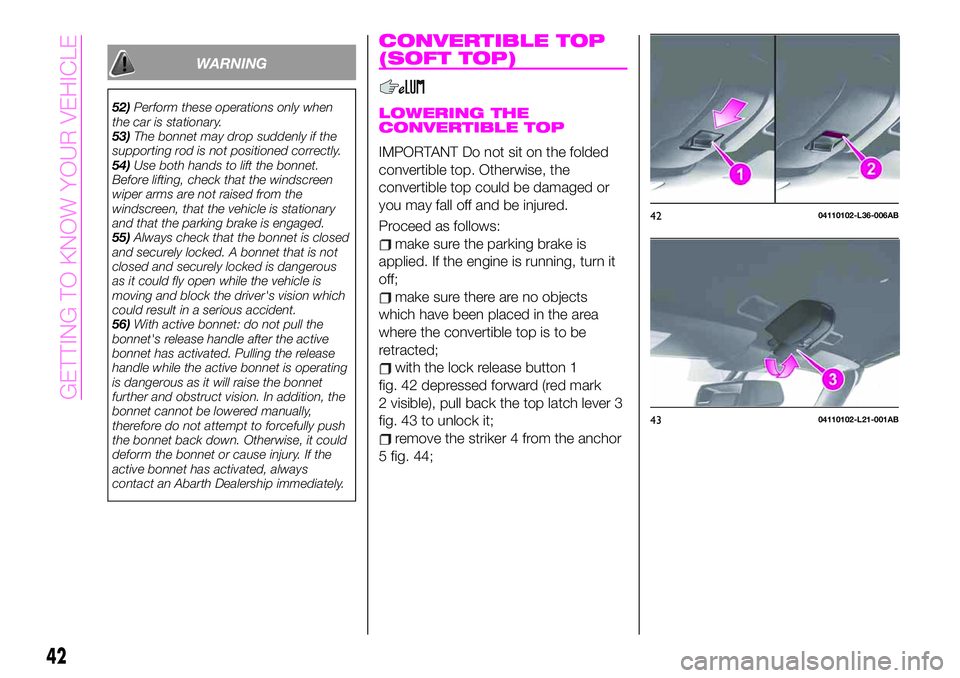
WARNING
52)Perform these operations only when
the car is stationary.
53)The bonnet may drop suddenly if the
supporting rod is not positioned correctly.
54)Use both hands to lift the bonnet.
Before lifting, check that the windscreen
wiper arms are not raised from the
windscreen, that the vehicle is stationary
and that the parking brake is engaged.
55)Always check that the bonnet is closed
and securely locked. A bonnet that is not
closed and securely locked is dangerous
as it could fly open while the vehicle is
moving and block the driver's vision which
could result in a serious accident.
56)With active bonnet: do not pull the
bonnet's release handle after the active
bonnet has activated. Pulling the release
handle while the active bonnet is operating
is dangerous as it will raise the bonnet
further and obstruct vision. In addition, the
bonnet cannot be lowered manually,
therefore do not attempt to forcefully push
the bonnet back down. Otherwise, it could
deform the bonnet or cause injury. If the
active bonnet has activated, always
contact an Abarth Dealership immediately.
CONVERTIBLE TOP
(SOFT TOP)
LOWERING THE
CONVERTIBLE TOP
IMPORTANT Do not sit on the folded
convertible top. Otherwise, the
convertible top could be damaged or
you may fall off and be injured.
Proceed as follows:
make sure the parking brake is
applied. If the engine is running, turn it
off;
make sure there are no objects
which have been placed in the area
where the convertible top is to be
retracted;
with the lock release button 1
fig. 42 depressed forward (red mark
2 visible), pull back the top latch lever 3
fig. 43 to unlock it;
remove the striker 4 from the anchor
5 fig. 44;
4204110102-L36-006AB
4304110102-L21-001AB
42
GETTING TO KNOW YOUR VEHICLE
Page 45 of 224
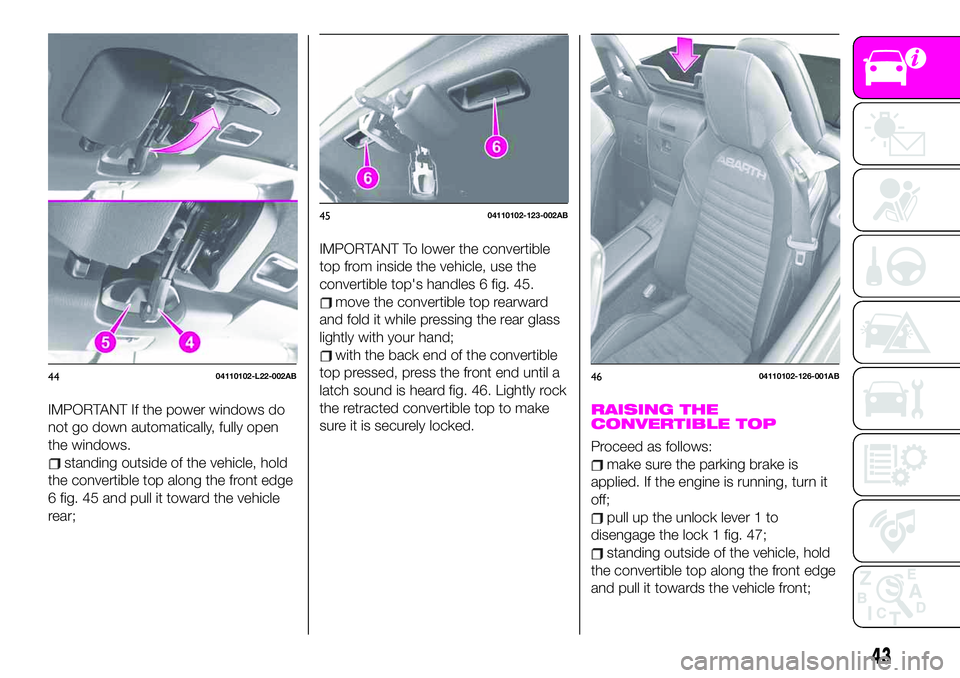
IMPORTANT If the power windows do
not go down automatically, fully open
the windows.
standing outside of the vehicle, hold
the convertible top along the front edge
6 fig. 45 and pull it toward the vehicle
rear;
IMPORTANT To lower the convertible
top from inside the vehicle, use the
convertible top's handles 6 fig. 45.
move the convertible top rearward
and fold it while pressing the rear glass
lightly with your hand;
with the back end of the convertible
top pressed, press the front end until a
latch sound is heard fig. 46. Lightly rock
the retracted convertible top to make
sure it is securely locked.
RAISING THE
CONVERTIBLE TOP
Proceed as follows:
make sure the parking brake is
applied. If the engine is running, turn it
off;
pull up the unlock lever 1 to
disengage the lock 1 fig. 47;
standing outside of the vehicle, hold
the convertible top along the front edge
and pull it towards the vehicle front;
4404110102-L22-002AB
4504110102-123-002AB
4604110102-126-001AB
43
Page 46 of 224

IMPORTANT If the power windows do
not go down automatically, fully open
the windows or open the doors.
IMPORTANT To raise the convertible
top from inside the vehicle, use the
convertible top's handles 2 fig. 48.
sitting in a seat, grasp the convertible
top's handles 3 fig. 49, and press the
convertible top against the windscreen.
Make sure the striker 4 engages with
the anchor 5, move the top latch slowly,
and then push the top latch upward
until a latch sound is heard.
IMPORTANT Driving with the
convertible top not fully locked could
damage the convertible top. If the red
indicator is visible on the lock releasebutton , the convertible top is not
locked. After locking the convertible
top, verify that the red indicator 6
fig. 50 is not visible (7 = locked position
/ 8 = unlocked position).
IMPORTANT Do not spray water
directly near the seam of the window
and convertible top when flushing away
dirt on the soft top with water.
Otherwise, water may enter the vehicle
(see paragraph “Convertible top
maintenance” in “Maintenance and
care” chapter).
4704110103-121-004-1AB
4804110103-L23-002AB
4904110103-L24-003AB
5004110103-124-001AB
44
GETTING TO KNOW YOUR VEHICLE
Page 47 of 224

CONVERTIBLE TOP
PRECAUTIONS
57) 58) 59) 60) 61)
12) 13) 0) 15) 16) 17) 18) 19) 20) 21)
Remove leaves or other matter that
may accumulate on and around the
convertible top. If leaves or other matter
block the drain filter, water may enter
the vehicle. Clean the drain filter at least
once a year.
Before opening the convertible top,
make sure the rear window defogger
switch is turned off. Otherwise the heat
generated from the defogger could
damage the convertible top and the
internal material.
Before lowering or raising the
convertible top, stop in a safe place off
the right-of-way and park on a level
surface.
Make sure nothing is on the
convertible top or near the back
window when raising or lowering the
convertible top.
Even small objects may interfere and
cause damage.
When lowering the convertible top,
make sure objects inside the vehicle are
not blown away by the wind.
Secure all loose objects inside before
driving with the convertible top down.
To help prevent burglary or vandalism
and to ensure that the passenger
compartment stays dry, close the
convertible top and both windows
securely and lock both doors when
leaving the vehicle.
Do not drive through an automatic
car wash; it may damage the
convertible top.
Do not raise or lower the convertible
top when the temperature is below 5 °C
(41 °F); this will damage the convertible
top material.
The soft top is made of high quality
material and if it is not maintained
correctly, the material could harden,
becomes stained, or have an uneven
gloss.
Do not lower the convertible top
when it's wet. If the convertible top
dries while folded, it will deteriorate and
mold.
Lowering the convertible top while
it's wet can also cause water to drip
into the passenger compartment.
Do not raise or lower the convertible
top in a strong wind as it could damage
the convertible top or cause an
unexpected accident.
The power windows go down
automatically in conjunction with the
convertible top opening/closing.
However, this is a function for improving
the operability, and it does not mean
there is a problem. If the vehicle battery
is disconnected for vehicle maintenance
or other reasons, the power windows
will not go down automatically. If the
power windows do not go down, the
automatic open/close mechanism for
the windows must be reset.
The windblocker reduces the amount
of wind coming into the cabin from
behind when driving with the
convertible top opened.
45
Page 48 of 224
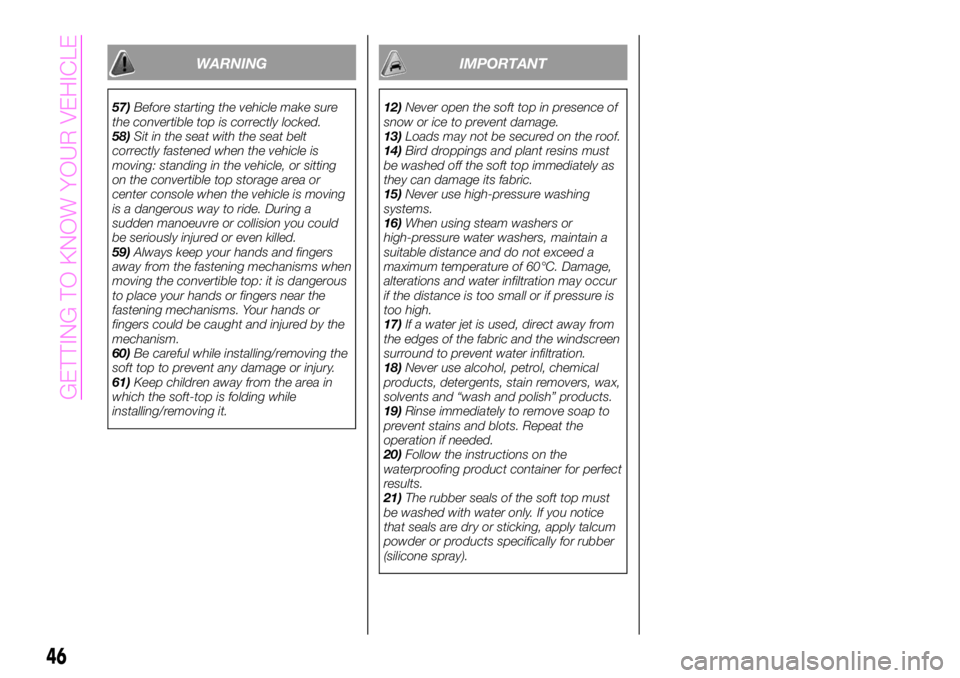
WARNING
57)Before starting the vehicle make sure
the convertible top is correctly locked.
58)Sit in the seat with the seat belt
correctly fastened when the vehicle is
moving: standing in the vehicle, or sitting
on the convertible top storage area or
center console when the vehicle is moving
is a dangerous way to ride. During a
sudden manoeuvre or collision you could
be seriously injured or even killed.
59)Always keep your hands and fingers
away from the fastening mechanisms when
moving the convertible top: it is dangerous
to place your hands or fingers near the
fastening mechanisms. Your hands or
fingers could be caught and injured by the
mechanism.
60)Be careful while installing/removing the
soft top to prevent any damage or injury.
61)Keep children away from the area in
which the soft-top is folding while
installing/removing it.
IMPORTANT
12)Never open the soft top in presence of
snow or ice to prevent damage.
13)Loads may not be secured on the roof.
14)Bird droppings and plant resins must
be washed off the soft top immediately as
they can damage its fabric.
15)Never use high-pressure washing
systems.
16)When using steam washers or
high-pressure water washers, maintain a
suitable distance and do not exceed a
maximum temperature of 60°C. Damage,
alterations and water infiltration may occur
if the distance is too small or if pressure is
too high.
17)If a water jet is used, direct away from
the edges of the fabric and the windscreen
surround to prevent water infiltration.
18)Never use alcohol, petrol, chemical
products, detergents, stain removers, wax,
solvents and “wash and polish” products.
19)Rinse immediately to remove soap to
prevent stains and blots. Repeat the
operation if needed.
20)Follow the instructions on the
waterproofing product container for perfect
results.
21)The rubber seals of the soft top must
be washed with water only. If you notice
that seals are dry or sticking, apply talcum
powder or products specifically for rubber
(silicone spray).
46
GETTING TO KNOW YOUR VEHICLE
Page 58 of 224
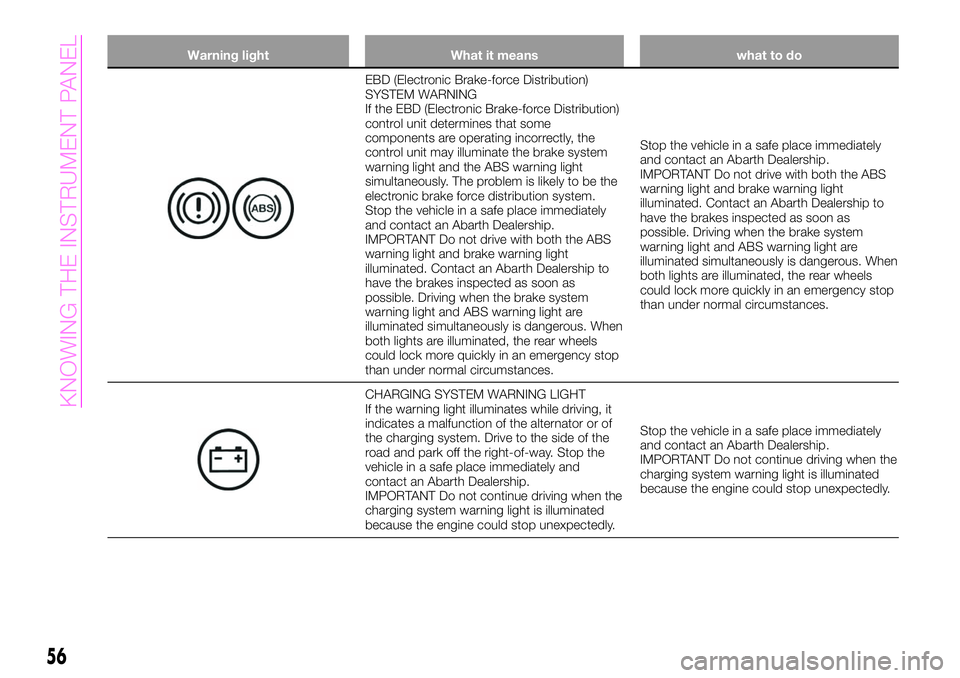
Warning light What it means what to do
EBD (Electronic Brake-force Distribution)
SYSTEM WARNING
If the EBD (Electronic Brake-force Distribution)
control unit determines that some
components are operating incorrectly, the
control unit may illuminate the brake system
warning light and the ABS warning light
simultaneously. The problem is likely to be the
electronic brake force distribution system.
Stop the vehicle in a safe place immediately
and contact an Abarth Dealership.
IMPORTANT Do not drive with both the ABS
warning light and brake warning light
illuminated. Contact an Abarth Dealership to
have the brakes inspected as soon as
possible. Driving when the brake system
warning light and ABS warning light are
illuminated simultaneously is dangerous. When
both lights are illuminated, the rear wheels
could lock more quickly in an emergency stop
than under normal circumstances.Stop the vehicle in a safe place immediately
and contact an Abarth Dealership.
IMPORTANT Do not drive with both the ABS
warning light and brake warning light
illuminated. Contact an Abarth Dealership to
have the brakes inspected as soon as
possible. Driving when the brake system
warning light and ABS warning light are
illuminated simultaneously is dangerous. When
both lights are illuminated, the rear wheels
could lock more quickly in an emergency stop
than under normal circumstances.
CHARGING SYSTEM WARNING LIGHT
If the warning light illuminates while driving, it
indicates a malfunction of the alternator or of
the charging system. Drive to the side of the
road and park off the right-of-way. Stop the
vehicle in a safe place immediately and
contact an Abarth Dealership.
IMPORTANT Do not continue driving when the
charging system warning light is illuminated
because the engine could stop unexpectedly.Stop the vehicle in a safe place immediately
and contact an Abarth Dealership.
IMPORTANT Do not continue driving when the
charging system warning light is illuminated
because the engine could stop unexpectedly.
56
KNOWING THE INSTRUMENT PANEL
Page 73 of 224
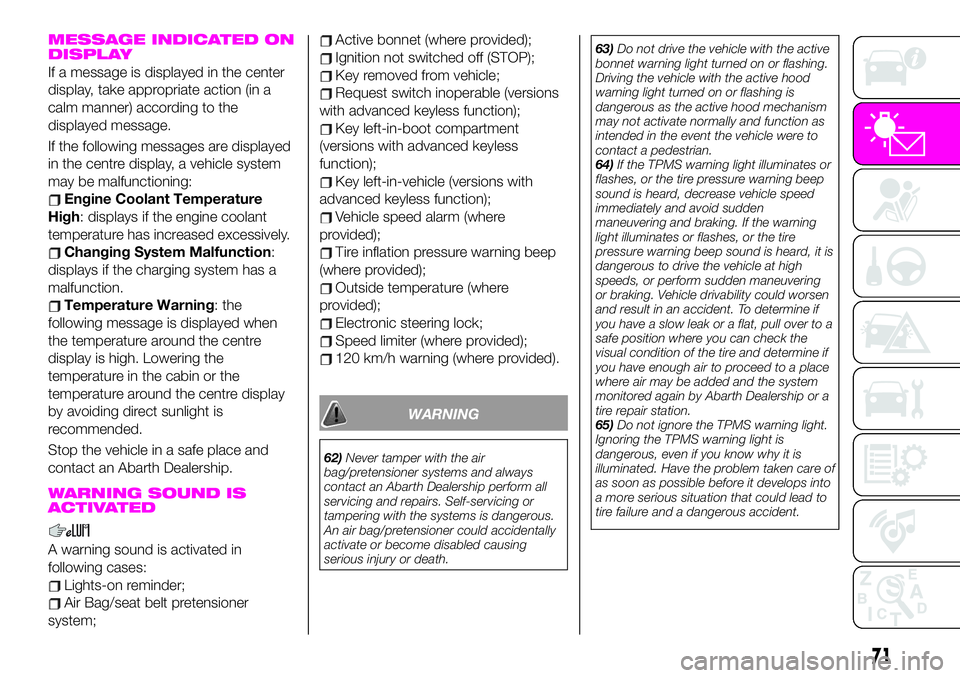
MESSAGE INDICATED ON
DISPLAY
If a message is displayed in the center
display, take appropriate action (in a
calm manner) according to the
displayed message.
If the following messages are displayed
in the centre display, a vehicle system
may be malfunctioning:
Engine Coolant Temperature
High: displays if the engine coolant
temperature has increased excessively.
Changing System Malfunction:
displays if the charging system has a
malfunction.
Temperature Warning: the
following message is displayed when
the temperature around the centre
display is high. Lowering the
temperature in the cabin or the
temperature around the centre display
by avoiding direct sunlight is
recommended.
Stop the vehicle in a safe place and
contact an Abarth Dealership.
WARNING SOUND IS
ACTIVATED
A warning sound is activated in
following cases:
Lights-on reminder;
Air Bag/seat belt pretensioner
system;
Active bonnet (where provided);
Ignition not switched off (STOP);
Key removed from vehicle;
Request switch inoperable (versions
with advanced keyless function);
Key left-in-boot compartment
(versions with advanced keyless
function);
Key left-in-vehicle (versions with
advanced keyless function);
Vehicle speed alarm (where
provided);
Tire inflation pressure warning beep
(where provided);
Outside temperature (where
provided);
Electronic steering lock;
Speed limiter (where provided);
120 km/h warning (where provided).
WARNING
62)Never tamper with the air
bag/pretensioner systems and always
contact an Abarth Dealership perform all
servicing and repairs. Self-servicing or
tampering with the systems is dangerous.
An air bag/pretensioner could accidentally
activate or become disabled causing
serious injury or death.63)Do not drive the vehicle with the active
bonnet warning light turned on or flashing.
Driving the vehicle with the active hood
warning light turned on or flashing is
dangerous as the active hood mechanism
may not activate normally and function as
intended in the event the vehicle were to
contact a pedestrian.
64)If the TPMS warning light illuminates or
flashes, or the tire pressure warning beep
sound is heard, decrease vehicle speed
immediately and avoid sudden
maneuvering and braking. If the warning
light illuminates or flashes, or the tire
pressure warning beep sound is heard, it is
dangerous to drive the vehicle at high
speeds, or perform sudden maneuvering
or braking. Vehicle drivability could worsen
and result in an accident. To determine if
you have a slow leak or a flat, pull over to a
safe position where you can check the
visual condition of the tire and determine if
you have enough air to proceed to a place
where air may be added and the system
monitored again by Abarth Dealership or a
tire repair station.
65)Do not ignore the TPMS warning light.
Ignoring the TPMS warning light is
dangerous, even if you know why it is
illuminated. Have the problem taken care of
as soon as possible before it develops into
a more serious situation that could lead to
tire failure and a dangerous accident.
71
Page 75 of 224

ACTIVE SAFETY
SYSTEMS
The vehicle has the following active
safety systems:
ABS (Anti-lock Braking System);
TCS (Traction Contol System);
DSC (Dynamic Stability Control);
Active bonnet (active pedestrian
protection).
For the operation of the systems, see
the following pages.
ABS SYSTEM (Antilock
Brake System)
66) 67) 68) 69)
The ABS control unit continuously
monitors the speed of each wheel. If
one wheel is about to lock up, the ABS
responds by automatically releasing
and reapplying that wheel's brake.
The driver will feel a slight vibration in
the brake pedal and may hear a
chattering noise from the brake system.
This is normal ABS system operation.
Continue to depress the brake pedal
without pumping the brakes.
The warning light turns on when the
system has a malfunction. Refer to
“Warning lights and messages”
paragraph in “Knowing the instrument
panel” chapter.
NOTE Braking distances may be longer
on loose surfaces (snow or gravel, forexample) which usually have a hard
foundation. A vehicle with a normal
braking system may require less
distance to stop under these conditions
because the tires will build up a wedge
of surface layer when the wheels skid.
NOTE The sound of the ABS operating
may be heard when starting the engine
or immediately after starting the vehicle,
however, it does not indicate a
malfunction.
TCS SYSTEM (Traction
Control System)
70) 71) 72)
The Traction Control System (TCS)
enhances traction and safety by
controlling engine torque and braking.
When the TCS detects driving wheel
slippage, it lowers engine torque and
operates the brakes to prevent loss of
traction.
This means that on a slick surface, the
engine adjusts automatically to provide
optimum power to the drive wheels,
limiting wheel spin and loss of traction.
The warning light turns on when the
system has a malfunction. Refer to
“Warning lights and messages”
paragraph in “Knowing the instrument
panel” chapter.
NOTE To turn off the TSC, press the
DSC OFF switch.
TCS / DSC indicator light
Theindicator light stays on for a few
seconds when the ignition is switched
ON.
If the TCS or DSC is operating, the
indicator light flashes.
If the
light stays on, the TCS, DSC or
the brake assist system may have a
malfunction and they may not operate
correctly. Contact an Abarth Dealership.
IMPORTANT In addition to the warning
light flashing, a slight labouring sound
will come from the engine. This
indicates that the TCS/DSC is
operating properly.
IMPORTANT On slippery surfaces, such
as fresh snow, it will be impossible to
achieve high rpm when the TCS is on.
DSC SYSTEM (Dynamic
Stability Control)
73) 74) 75)
The Dynamic Stability Control (DSC)
automatically controls braking and
engine torque in conjunction with
systems such as ABS and TCS to help
control side slip when driving on
slippery surfaces, or during sudden or
evasive manoeuvring, enhancing vehicle
safety. Refer to “ABS system (Antilock
Brake System)” and “TCS system
(Traction Control System)”.
73